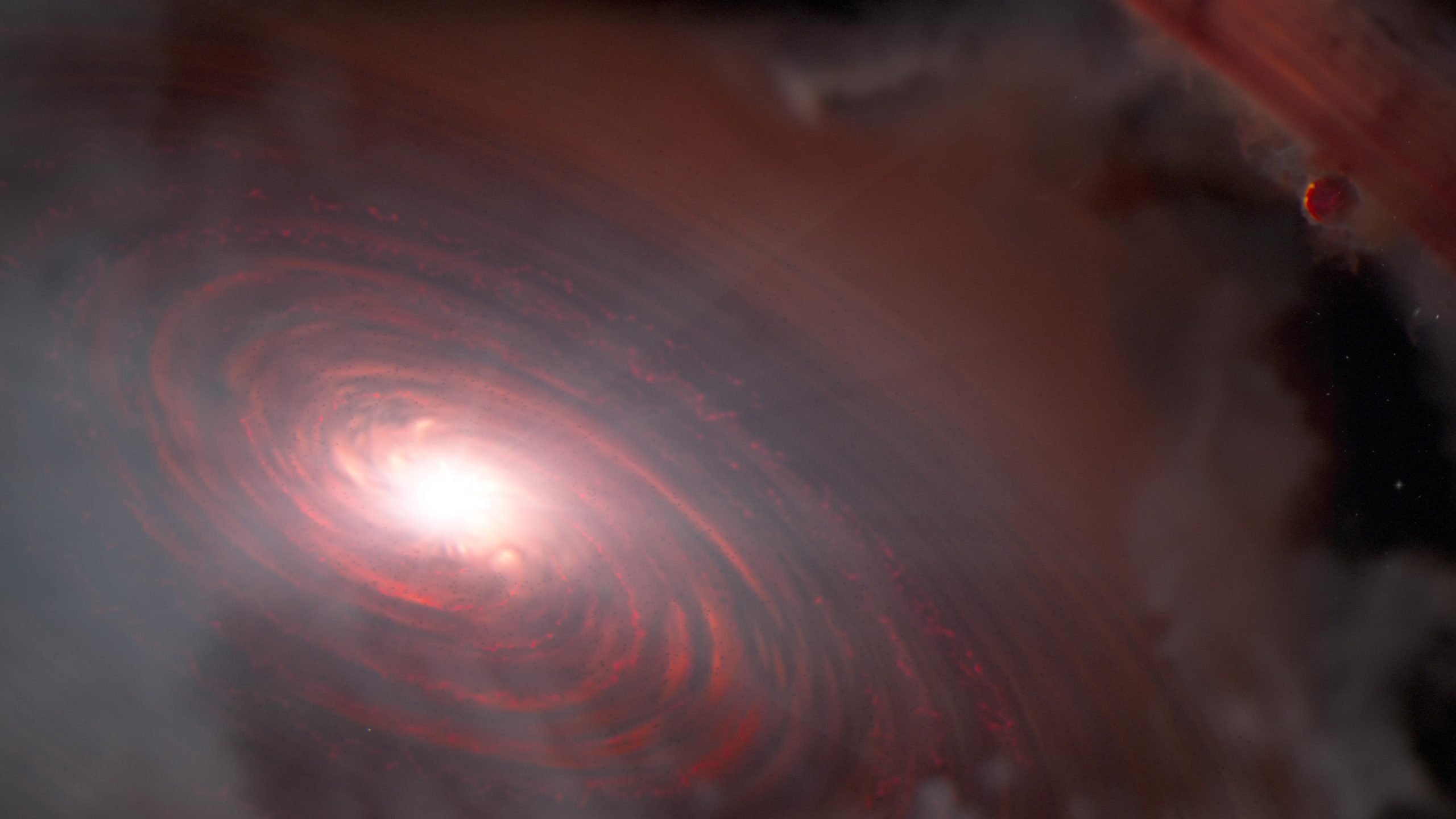
This artist’s concept depicts the star PDS 70 and its inner protoplanetary disk. New measurements by NASA’s James Webb Space Telescope have revealed water vapor at distances less than 100 million miles from the star — the region where rocky and terrestrial planets may form. This is the first detection of water in the terrestrial region of a disk already known to host two or more protoplanets, one of which is shown in the upper right. Credit: NASA, ESA, CSA, Joseph Olmsted (STScI)
The discovery shows that there is a reservoir of water available for terrestrial planets that might coalesce there.
Water, water, everywhere – not in drops, but as steam. scientists using NASA‘s James Webb Space Telescope They discovered that thirsty planets in the PDS 70 system have access to a reservoir of water. Most importantly, the water vapor was found within 100 million miles of the star – the region where terrestrial planets like Earth might form. (Earth orbits about 93 million miles from our sun.)
PDS 70 is much cooler than our Sun, with an estimated age of 5.4 million years. It is home to two known gas giant planets, at least one of which is still accumulating material and growing. This is the first detection of water in the terrestrial region of a disk already known to host two or more protoplanets.

The protoplanetary disk spectrum of PDS 70, obtained with Webb’s MIRI (mid-infrared instrument), displays a number of emission lines from water vapor. Scientists have determined that water is present in the system’s inner disk, at distances less than 100 million miles from the star — the region where rocky and terrestrial planets might form. Credit: NASA, ESA, CSA, Joseph Olmsted (STScI)
The Webb Space Telescope detects water vapor in the rocky planet formation region
Water is essential to life as we know it. However, how water got to Earth and whether the same processes could sow the seeds of rocky exoplanets orbiting distant stars remain subjects of scientific debate. These discussions may benefit from new insights from the PDS 70 planetary system, located 370 light-years away. This star system includes an inner and outer disk of gas and dust, separated by a gap of 5 billion miles (or 8 billion kilometers). Two known gas giant planets reside within this gap.
New data collected by the MIRI (mid-infrared instrument) of NASA’s James Webb Space Telescope revealed water vapor in the system’s inner disk, at distances less than 100 million miles (160 million km) from the star — the region where rocky and terrestrial planets may form. (Earth orbits about 93 million miles from our sun.) It should be noted that this is the first time that water has been detected in the terrestrial region of a disk that has already been confirmed to host two or more protoplanets.
“We’ve seen water in other disks, but not so close to a system where planets are currently clustering. We haven’t been able to make this kind of measurement before Webb,” said lead author Giulia Perotti of the Max Planck Institute for Astronomy (MPIA) in Heidelberg, Germany.
“This discovery is very exciting, as it explores the region in which rocky, Earth-like planets usually form,” added MPIA Director Thomas Henning, a co-author on the paper. Henning is the co-principal investigator for Webb’s MIRI (Mid-Infrared Disk Survey) program, which did the detection, and the principal investigator for the MINDS (MIRI Mid-Infrared Disk Survey) program, which took the data.
Steamy environment for planet formation
PDS 70 is a K-type star, which is much cooler than our Sun, with an estimated age of 5.4 million years. This is relatively old in terms of stars with planet-forming disks, which made the discovery of water vapor surprising.
Over time, the gas and dust content of the planet-forming disks decreases. Either the central star’s radiation and winds blow away such material, or the dust grows into larger bodies that eventually form planets. Because previous studies failed to detect water in the central regions of disks of similar age, astronomers suspected that it might not survive the harsh stellar radiation, leading to a dry environment for the formation of any rocky planets.
Astronomers have not yet detected any planets forming within the inner disk of PDS 70. However, they do see the raw materials for building rocky worlds in the form of silicates. The discovery of water vapor suggests that if rocky planets were forming there, they would have had water available to them from the start.
We found a fairly large amount of small dust grains. Besides our discovery of water vapor, the inner disk is a very exciting place to be, said co-author Renz Waters of Radboud University in the Netherlands.
What is the origin of water?
This discovery raises the question of the source of the water. The MINDS team looked at two different scenarios to explain their findings.
One possibility is that water molecules form in place, as we detect them, when hydrogen and oxygen atoms recombine. A second possibility is that the ice-covered dust particles move from the cold outer disk to the hot inner disk, where the water ice sublimates and turns into vapor. This transportation system would be surprising, since the dust would have to cross the huge chasm formed by the two giant planets.
Another question raised by this discovery is how water can survive so close to a star, when the star’s ultraviolet light must break any water molecules. Most likely, surrounding materials such as dust and other water particles act as a protective shield. As a result, water detected in the inner disk of PDS 70 could escape destruction.
Ultimately, the team will use two other Webb instruments, NIRCam (Near Infrared Camera) and NIRSpec (Near Infrared Spectrometer), to study PDS 70 in an effort to derive greater understanding.
These observations were taken as part of Guaranteed Time Observation 1282. This finding has been published in the journal nature.
Reference: “Water in the planet-forming region of PDS 70” by G. Perotti, V. Christiaens, Th. Henning, B. Tabone, LBFM, Waters, I. Camp, G. Lagage, T. P. Ray, B. Vandenbussche, A. Abergel, O. Absil, A. M. Arabhavi, I. Argyriou, D. Barrado, A. Boccaletti, A. Caratti o Garatti, V. Geers, A. M. Glauser, K. Justannont, F. Lahuis, M. Onn, N. nature.
DOI: 10.1038/s41586-023-06317-9
The James Webb Space Telescope is the world’s premier space science observatory. Webb solves mysteries in our solar system, looks beyond to distant worlds around other stars, and investigates mysterious structures and the origins of the universe and our place in it. Webb is an international program led by NASA with its partner, ESA (European Space Agency) and the Canadian Space Agency.

“Web maven. Infuriatingly humble beer geek. Bacon fanatic. Typical creator. Music expert.”





More Stories
Astronomers solve the mystery of the dramatic 1936 explosion of FU Orionis
NASA Commercial Crew Comparison Boeing Starliner and SpaceX Dragon
Japanese “Moon Sniper” brings back images after the third long lunar night